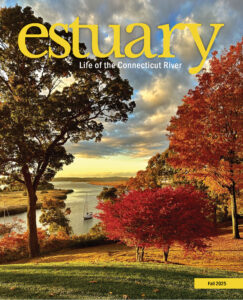 This article appears in the Fall 2025 issue
This article appears in the Fall 2025 issue
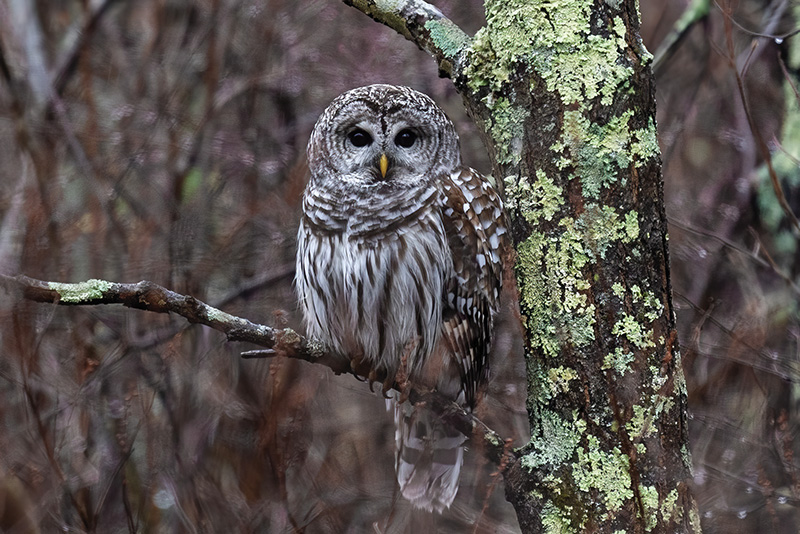
One of the pair of adult barred owls, East Haddam, CT.
Barred Owls in the Backyard
By Bill Hobbs | Photos by Frank DiNardi
One of the pair of adult barred owls, East Haddam, CT.. “Every couple of weeks, I would post a video [to social media],” DiNardi remembered fondly, “and so many people would post back, saying, ‘Wow! In a time of such darkness in the world, this story of yours has brought a smile to my face.’”
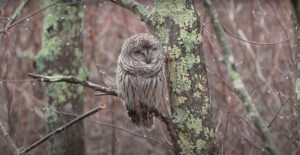
DiNardi filmed and took still photos of the owls
in the swampy area near his father’s home
from late 2019 to late summer 2020.
DiNardi, 43, makes a living photographing weddings, real estate properties, golf courses, and restaurant cuisine with stunning clarity. He started his owl project in late 2019, three months before the official outbreak of the pandemic. Each time he posted a little film clip of the baby barred owls on Facebook and Instagram, poking their heads out of the nesting box, or receiving food transfers from their parents, he would almost instantly receive an average of 1,000 to 1,500 views and 150 to 300 likes. The hour-long documentary that he posted to YouTube in January 2021, called “The Ultimate Barred Owl Experience,” garnered 44,000 views by the end of May 2025. “It was a very heartwarming moment,” DiNardi recalled. Barred owls are medium-sized owls, standing about 21 inches tall, with a wingspan of 39 to 43 inches. They get their name from the brown bars on their chest and the vertical streaks along their belly. Barred owls are best known for their haunting calls, often described as sounding like the phrase, “Who cooks for you? Who cooks for you—all?”
Their scientific name is Strix varia. The genus name “Strix” is a Greek word, meaning an owl with the keenest hearing and sharpest eyesight, an appropriate description for this species. These beautiful birds of prey inhabit wooded river bottoms and swamps and are commonly found across all states east of the Mississippi River, throughout much of southern Canada, and since the 1970s, in the Pacific Northwest where they are threatening the native northern spotted owls.
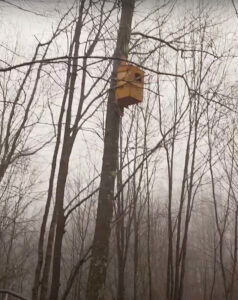
rank DiNardi and his father built a barred owl nesting box from plans they found online and hung it on a tree 20 feet up in late December 2019.
A Nesting Box Solution
DiNardi and his father knew that barred owls lived in a forested swampland near their home—the birds’ distinctive calls often echoed through the trees. DiNardi had recently taken an interest in bird photography and was eager to capture the owls on camera. However, he wasn’t sure how to attract them closer to the house, where he and his dad could observe and photograph them more easily. According to their research, one of the most effective ways to attract barred owls was to build a nesting box and hang it in a known barred owl habitat. They thought it was worth a try.
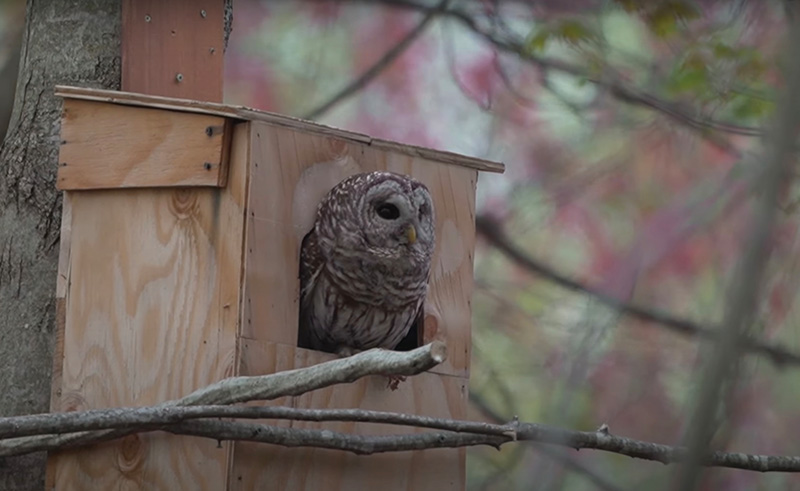
DiNardi was thrilled when he first saw the adults entering and exiting the nesting box in late winter 2020.
DiNardi and his dad built a nesting box from scrap wood following specifications they found online: 23 inches tall, 13 inches wide, with a 13 x 12.4-inch floor, and a 7-inch-diameter entrance hole cut into the front. They hung it about twenty feet up in a tree on the edge of his father’s property near a swamp.
By then it was mid-December, a perfect time to hang a barred owl nesting box. Barred owl mating and breeding season in the Northeast typically starts in February and ends in August. Experts recommend putting the nesting box up in a tree at least a month or two before mating season so that the owls can find the box and be comfortable with it.
The nesting box location they chose proved to be spot on. According to the Cornell Lab of Ornithology’s website, allaboutbirds.org, barred owls favor mostly dense, thick woods, with scattered clearings, especially in low lying, swampy areas because they supplement their normal diet of rodents with frogs, salamanders, crayfish, and aquatic insects.

Professional photographer Frank DiNardi studied a pair of barred owls as they mated and raised young owlets adjacent to his backyard during the COVID pandemic in 2020.
“This was such an exciting time for me,” DiNardi said, recalling he often spotted barred owls nearby. They seemed curious about the box, but he wasn’t sure whether to photograph them or let them be. He waited.
Two months later, he watched in amazement as a barred owl flew straight to the box and peered inside. “Holy smokes,” he thought. “They’re actually interested—there’s a real chance they might use it.”
On his next visit, DiNardi said, “I was so curious. I mounted a GoPro camera on the end of a long broomstick, held it up to the opening for a few seconds, and angled it at 45 degrees to see inside. When I reviewed the footage, sure enough, the female was in there, probably sitting on eggs.”
Flight Lessons in the Backyard
Barred owls typically lay one to five eggs, which the female incubates for twenty-eight to thirty-three days. During this time, DiNardi said, the male played a key role by providing food—mostly mice—for both the female and the hatchlings, serving as their essential lifeline.
Then on May 4, 2020, DiNardi and his dad got the gift they had waited so long for: the first of three owlets emerged from the box.
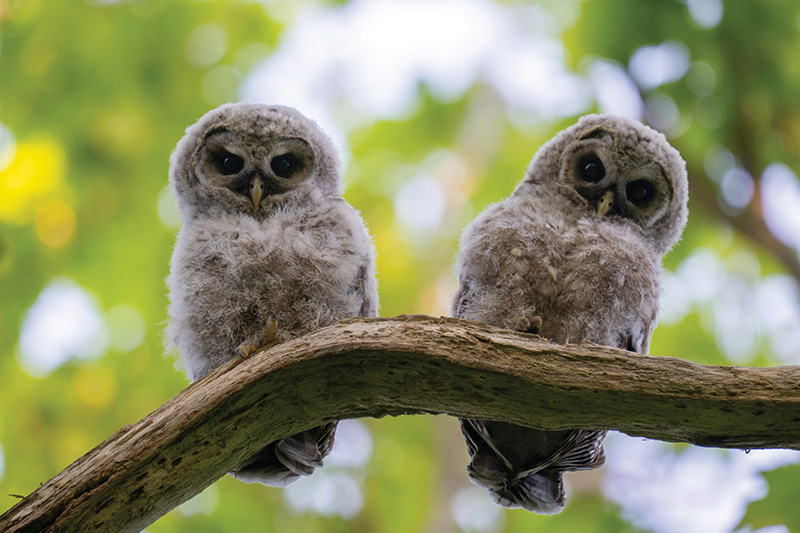
DiNardi observed that two of the three baby owls were often found together.
As the owlets grew and their fluffy, pale down was replaced with juvenile feathers, DiNardi was amazed at how open and unafraid they were, hanging around his dad’s house, and sitting on top of Adirondack chairs, the deck railing, or on his dad’s car.
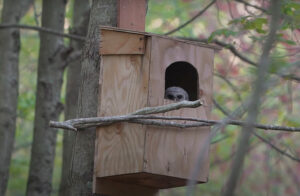
Captured on video, the baby owlets take turns looking out of the nesting box.
“I always wore a black hat, a black jacket, and dark pants when I visited them,” DiNardi said. “I even gave the owlets names—Ollie, Omar, and Olympus—and talked to them. And the adults, Mom and Dad, didn’t seem to mind me being there. I think we shared a kind of mutual respect.”
During the owlets first flights, DiNardi said they were “very animated,” hopping between branches and making short, ten-foot flights. He remembered feeling happy watching their progress, but also a little sad. “I thought, now they’re going to be harder to track.”
In fact by August 2020, DiNardi said, Ollie, Omar, and Olympus had nearly reached adulthood and ventured off, likely in search of new, unclaimed territory.
A Wedding Gift from the Woods
But that wasn’t the end of the story.
DiNardi observed the adult pair returning to the nesting box for two more years, raising two owlets in 2021, and three in 2022. But in 2023, the box fell. His father’s health prevented him from immediately rehanging it. DiNardi had moved to East Lyme, Connecticut, after getting married, and the box sat on the ground for two months before he and his dad were able to rehang it. Unfortunately, the owls never returned. “When that box fell,” DiNardi said, “I think it scared them, and they decided not to use it anymore.”
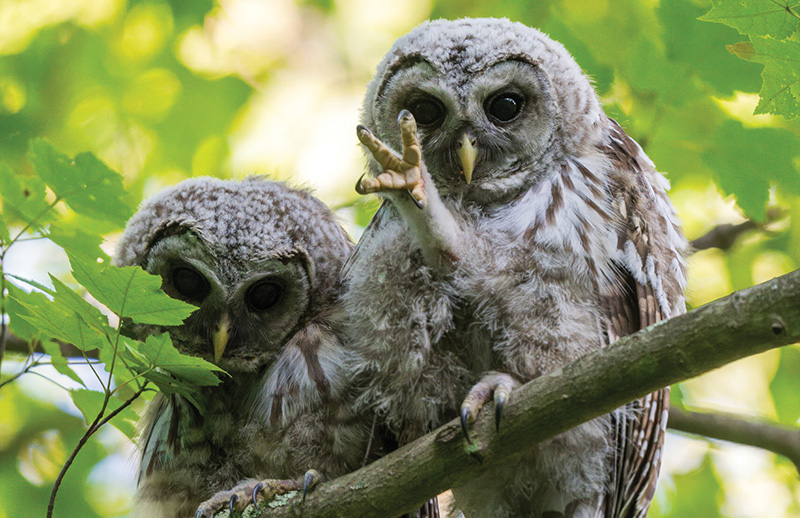
Young owl developing its ferocity.
Then DiNardi received an unexpected wedding gift. “During our first week in the new house,” he recalled, “my wife and I were having dinner with the sliding glass door open when I heard a rustling outside. I stepped out expecting to see a deer or maybe a coyote—but there was nothing. I went back inside, but the sound came again. This time when I looked, I spotted a barred owl perched in a nearby tree, and I remember thinking, “Well, imagine that—barred owls live here, too.”
In jest, I told Frank, “Those owlets must have come looking for you.”
Smiling, DiNardi said, “You never know. There are some crazy things that happen in the world of wildlife.”
Bill Hobbs is a contributing wildlife journalist for Estuary magazine and The Times newspapers of New London, CT. He welcomes your comments at whobbs246@gmail.com.
Visit estuarymagazine.com/the-ultimate-barred-owl-experience/ for a quick link to DiNardi’s documentary,
“The Ultimate Barred Owl Experience.”
